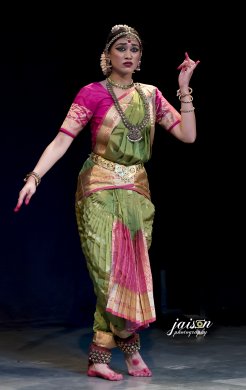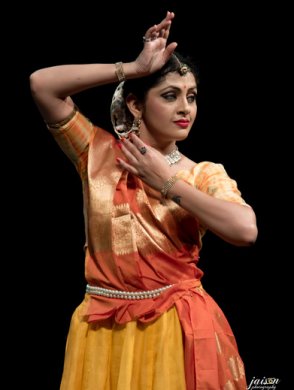
|   |

|   |
 e-mail: leelakaverivenkat@gmail.com Dancing to poetry of liberated women saint poets Photos courtesy: Jaison Thomas March 25, 2018 An evening of dance centred round the poetry of women bhakti poets Andal and Meera, hailing from the South and North of India respectively, was in keeping with the mood of International Women's Day celebrated in early March. Designed by cultural activist R.K. Usha, the evening jointly mounted with Sangeet Shyamala at the latter's venue in Vasant Vihar, Delhi, featured two young dancers Shreyasi Gopinath and Shipra Joshi, representing two forms of Bharatanatyam and Kathak. In terms of taking programmes to audiences in different localities (the large formal auditoriums being too far away), this intimate performance area in Sangeet Shyamala's basement facing a gallery style seating, attracted an enthusiastic turnout and seemed an excellent way of familiarising people in various areas. The bhakti poetry of these women testifies not only to their creativity but also to their courage in standing up for their chosen ideals in defiance of prevalent social norms. Andal growing up in Srivilliputtur, the only woman among the Alwar poets (6th – 8th centuries), in her love poetry dedicated to the Lord of Srirangam, as a liberated woman, is unafraid of declaring her passionate desire in bold terms. She uses erotic poetic images and metaphors of the body in stating her love. In the South, during the margazhi season unmarried girls, in the belief that it will fetch them a good husband, observe the month by singing the 30 songs of Andal's 'Tiruppavai'. Andal's 'Nachiyar Tirumozhi' of over 100 compositions, treats spirituality and erotic desire as two sides of the same passion.  Shreyasi Gopinath In a recital choreographed by her guru Jamuna Krishnan, Shreyasi Gopinath's Bharatanatyam curtain raiser was a neatly presented Pushpanjali in the raga Varali, set to khanda jati ata talam. Addressing the lord with loving epithets urging him to become one with her, the dancer, given her animated, expressive interpretative ability, went on to one of the most popular Andal compositions Varanamayiram - the verses describing her dream of being wedded to Ranganatha, the fertile imagination in sleep visualising every little ritual like the procession with 400 elephants, the festooned pandal, flowers and fragrance all round. Set to ragas Bowli and Hindolam, the crucial impact also drew on the tuneful, involved vocal support of K. Venkateshwaran who along with the clarity of Ragini Chandrasekhar's nattuvangam, mridangam by Chandrasekhar and evocative violin and flute interventions by Raghavendraprasad and Aniruddha respectively, provided an inspiring musical framework. Very typical of Andal's suggestive eroticism was Karpooram naarumo, wherein, addressing the Lord's conch which has the good fortune of being held close to his mouth, Andal curiously asks as to what Ranganatha's lips taste like. Does his beautiful mouth smell of camphor, the nectar of flowers? Set to ragas Athana and Sindhubhairavi, the dancer's training under Jamuna has made her evolve enough to evoke the subtext of deep desire where Andal wants to be in the place of the conch. The concluding part underlined Andal's unrequited pangs for the Lord sleeping undisturbed on his serpent couch, while she is like the ocean waters churned by the gods and demons. Pleading with the cuckoo bird to deliver her message of love to the Lord, who in the Yamuna waters danced on the serpent's head, she wonders if she will survive this agony. Apart from each statement in the ragamalika evocatively set in Kamas, Ranjani, Sama and Yamunakalyani, the jatis composed by Karaikudi Krishnamurthy, apart from providing rhythmic relief, contributed in pace and tone to the mood of poetry.  Shipra Joshi Woven round the prema bhakti of Meera, who fought and rebelled against the walled orthodoxy of Rajasthani royalty to pursue her love for Krishna, Shipra Joshi, a Kathak disciple of Prerana Shrimali, opened with a Meera bhajan - the delightfully secretive Meera, asking Shyam to visit her through the backdoor to avoid the gossiping curiosity of all eyes. It was wonderful to see how the Kathak nritta intra-forms with a subtle ghungat ki gat were smoothly woven into the main fabric of the song which all in one motion slipped into a fast lehra background for footwork. Along with her foot sure nritta and clean ang, Shipra has the inner feel for the dance, which one can experience in her rendition. Music composed by Samiullah Khan was extremely well sung by Kuldeep Gangani. Accompanied by Akhilesh Bhatt on the tabla, Umashankar on sitar and Vishwajeet providing padhant, the music was kept at a decibel level which was soothing. The More janam janam sathi in Keerawani had all the immersed bhakti feel. Along with her stage presence, and her talents, Shipra under a good teacher, is a dancer to watch out for.  Writing on the dance scene for the last forty years, Leela Venkataraman's incisive comments on performances of all dance forms, participation in dance discussions both in India and abroad, and as a regular contributor to Hindu Friday Review, journals like Sruti and Nartanam, makes her voice respected for its balanced critiquing. She is the author of several books like Indian Classical dance: Tradition in Transition, Classical Dance in India and Indian Classical dance: The Renaissance and Beyond. Post your comments Please provide your name and email id when you use the Anonymous profile in the blog to post a comment. All appropriate comments posted with name & email id in the blog will also be featured in the site. |